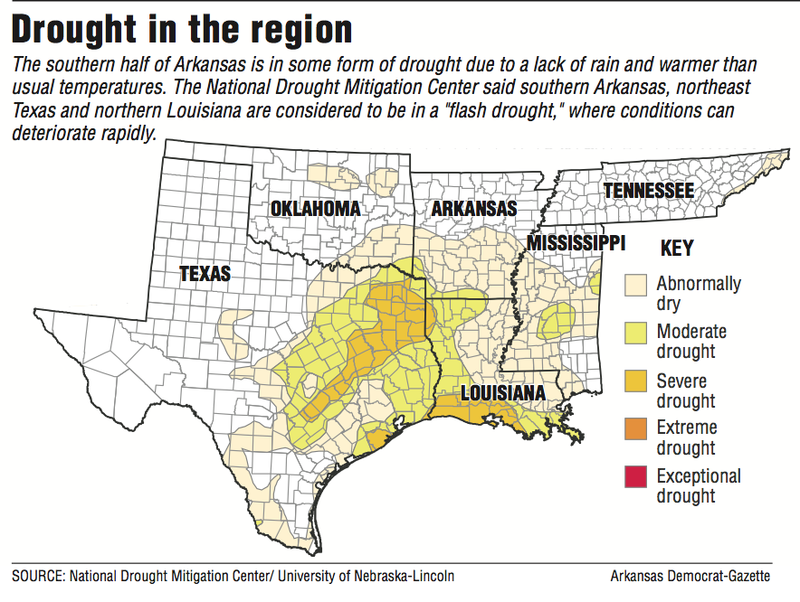Despite showers Thursday and more forecast for today, climatologists consider southern Arkansas, northeast Texas and northern Louisiana to be in a "flash drought" because of a prolonged dry spell, and conditions are expected to deteriorate rapidly unless more rain falls.
Nearly half of the state is classified as having some form of drought, according to a weekly report issued by the National Drought Mitigation Center at the University of Nebraska-Lincoln. The center -- which evaluates rainfall totals, temperatures and other climate data in preparing its reports -- said 45.3 percent of the state is in a drought.
Just two weeks ago, only 5.7 percent of Arkansas was experiencing drought conditions.
Arkansas last saw a flash drought in May 2012, when conditions deteriorated rapidly over the summer.
Now, the western edge of Little River County in southwest Arkansas is considered in the worst shape and received a "moderate drought" rating by the center Thursday, meaning it has a deficiency of 1-2 inches of rain over a 30-day period.
Portions of seven counties that border Texas and Louisiana are "abnormally dry," meaning they are having a deficit of up to 1 inch of rainfall over a 30-day period.
"South Arkansas is seeing a flash drought," said Chris Fenimore, a climatologist with the National Oceanic and Atmospheric Administration in Asheville, N.C., who wrote this week's drought report. "You've had several days of warmer than average temperatures and a lack of rainfall."
This week's report compiled data through Tuesday and did not include Thursday's rainfall.
However, National Weather Service meteorologists said what rain did fall in southern Arkansas was sporadic and probably wouldn't affect the drought.
"We had varying amounts of rain all over the place," meteorologist Mario Valverde of Shreveport said of rainfall measured Wednesday and Thursday morning. "There were trace amounts of rain in Texarkana, a tenth of an inch in other areas, and then 1.5 inches of rain in Hope.
"A half an inch of rain could help out the drought, but it needs to be widespread."
Farther north in Arkansas, rainfall amounts varied greatly.
Beedeville, a southern Jackson County town, recorded 5.6 inches of rain in six hours Wednesday, meteorologist Dave Scheibe of North Little Rock said. Five miles to the east, scarce rainfall was measured.
North Little Rock recorded 0.71 inches of rain Wednesday and Thursday, while across the Arkansas River at Bill and Hillary Clinton National Airport/Adams Field, the gauge recorded 0.14 inches.
In the past few weeks, the drought increased quickly after southern Arkansas saw all-time low rainfall. For example, rain did not fall on El Dorado for 44 days, a record stretch since the National Weather Service began monitoring the town's rainfall in 1907.
The dry period contrasts with record high rainfall in May, which caused widespread flooding along the Red River in Little River, Lafayette, Hempstead and Miller counties.
"We had all that rain, and then the faucet turned off," Valverde said.
South-central Arkansas averaged only 0.03 inches of rain from July 16 through Aug. 14, the National Weather Service reported. The area normally receives about 3.5 inches of rain during the same period.
Thursday's rain in Miller County eased the worries of the county's forest ranger, but he is concerned the dry conditions will return.
"We were a few days away from getting to a critical stage," ranger Douglas Cherry said. "We were at the point the other day that when a car got a flat tire, sparks from the tire's rim on the highway caught grass on fire."
The Arkansas Forestry Commission said Thursday that the southern half of the state and portions of north-central Arkansas still were considered in moderate danger for wildfires. The agency urged residents to burn debris and trash in the early morning and evenings, when winds and humidity are minimal.
"People may get too optimistic about this rain and start burning again," Cherry said. "I'm a bit more pessimistic. That's my job to be so. If it stops raining now and the dry air returns, we could be back to dangerous burning conditions within three hours."
Larry Burgess, the county judge of Miller County, lifted a burn ban in his county Thursday afternoon. Eighteen counties in southern and central Arkansas remained under burn bans Thursday evening.
In Union County, cattle farmers began feeding their livestock hay that they cut in May because grass was drying up, said Robin Bridges, Union County cooperative extension agent.
"They were able to produce a lot of hay because of the rainfall in the spring," Bridges said. "We'll come through this pretty well. The quality of grass is not good enough for cattle to graze."
He said Thursday's rain will help farmers with rye grass production, which they can use as feed through the winter.
"This is the perfect time for rain," he said.
Forecasters predict El Nino, a warming of the southern Pacific Ocean, will result in colder and wetter conditions in Arkansas this fall and winter.
"If El Nino conditions continue -- and we're 90 percent sure they will -- we'll see a vast improvement in these drought conditions by the end of the year," Fenimore said.
State Desk on 08/21/2015

